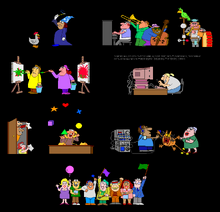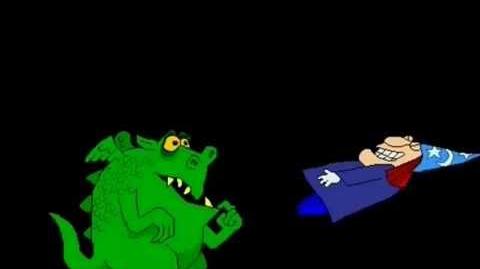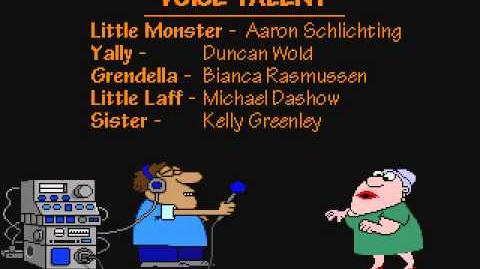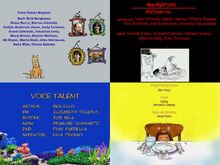
The Living Books Credits Sequences are in order of which they first debuted. From top to bottom, Wizard, Music, Painting, Programmer, Phone, Cheering, and Voiceover.

Living Books Credits (All 7 Sequences)
Every game includes a credits sequence accessible from the options menu. In most cases, these credits sequences not only list off the people who worked on the game, but also include an animation to accompany it. These animations all have the same style and many appear across multiple games in the series, and they are related to the current list of people displayed. They also all use a jazz score for the background music composed by Joey Edelman, and this in turn was usually included in its entirety as a bonus CD audio track. Four games in the series have a unique set of credits (more on that below). The credits sequences are listed in order of which they first debuted.
Wizard
A wizard attempts to create a dog out of nothing, but at first struggles making anything at all, then makes a rat but is dissatisfied, then morphs it to a chicken. Still frustrated, he tries one more time, and is successful at making a dog. However, as he is giving an aside for his accomplishment, the dog morphs into a large dragon unbeknowest to him. The dragon pulls the wizard's sleeve to get his attention, which completely scares the wizard and leads to him fainting. The dragon simply gives an aside glance, chuckling.
This credit sequence doesn't have any real consistency on who it includes; one game it may include the production staff, another it may include the artistic direction.
Appearances:
- Just Grandma and Me
- The Tortoise and the Hare
- Arthur's Birthday
- Sheila Rae, the Brave
- The Berenstain Bears in the Dark
Music
A pianist, a trombone player, and a double bass player all prepare to play the jazz score that accompanies the credits, with a one-man-band on the far right occasionally interrupting with cartoonish noises. The one-man-band is equipped with a whole slew of instruments, such as a saxophone, a bass drum, a bike horn, a cow bell, and even a green bird. After multiple interruptions occur, he finishes off by shooting a pop-gun. This is followed by glass breaking in the distance, shocking the other musicians.
This sequence is almost always accompanied by the sound team, including music, sound engineers, and voice actors. It has by far the most appearances across the Living Books games.
Apparances:
- Just Grandma and Me
- The New Kid on the Block
- Little Monster at School
- Arthur's Birthday
- Harry and the Haunted House
- The Berenstain Bears Get in a Fight
- Dr. Seuss's ABC
- Sheila Rae, the Brave
- The Berenstain Bears in the Dark
- Stellaluna
- Arthur's Reading Race
- The Cat in the Hat
- Green Eggs and Ham
Painting
A male and female artist are painting a red triangle and a green circle, respectively. The male painter mistakenly flings some of his to the female painter, which the female painter strikes back in retaliation by intentionally flinging her red paint back onto his green paint. This fight goes on for some time, until it eventually ends with them splashing their paint buckets on each other's canvases. However, their red triangle and green circle both shows up again afterwards, with each taking notice. They are both pleased by this, and shake hands.
This is almost always used when the artistic team is being listed off.
Appearances:
- Arthur's Teacher Trouble
- Little Monster at School
- Harry and the Haunted House
- The Berenstain Bears Get in a Fight
- Dr. Seuss's ABC
- Sheila Rae, the Brave
- The Berenstain Bears in the Dark
- Arthur's Reading Race
- The Cat in the Hat
- Arthur's Birthday (UK version only)
Programmer
A programmer sits in front of his computer, starting to type away. A bunch of nonsense code starts to appear above, but he takes it too far away and the cords turn burning red and kaboom! The computer eventually bursts and falls apart (in a cartoonish fashion). In the aftermath, a cube lands on the programmer's head, then he is exasperated, and the computer's screen starts blinking red and making electrical zapping noises. He chuckles at the player going "Ho-ho" (in the Arthur's Teacher Trouble version only).
This scene is typically accompanied with the programming team.
Appearances:
- Arthur's Teacher Trouble
- The New Kid on the Block [did not hear ceiling crash effect]
- Little Monster at School
- Arthur's Birthday
- Harry and the Haunted House [did not hear ceiling crash effect]
- Dr. Seuss's ABC [did not hear ceiling crash effect]
- Stellaluna
- Arthur's Reading Race
- The Cat in the Hat
- Just Grandma and Me (V2 only)
Phone
A worker is taking in calls from two phones at the same time, all while a group of people open the door to his left and start tossing him all sorts of shapes, all while he begins to juggle them. After the group of people leave, the worker tosses his shapes up into the air, and starts catching all of the falling shapes and stacking them up onto his finger. After that, the worker gives an aside glance and waves his arm out, with one phone hanging on his arm and ringing.
This is an obvious visual representation of what working on the production staff can feel like, showing how many things they can have to worry about at once. Likewise, the production staff is usually featured whenever this one comes up.
Appearances:
Voiceover

A Rare Credits Sequence
A guy with headphones and using a recording machine holds a microphone up to the lady, and the lady screams very loud and blows the guy's headphones away, and the volume meter on the recording machine displays very large sound waves. The headphones fling back onto the guy's head, and the guy then decides to do a sound test on the kitty cat. The lady then steps on the cat's tail, the cat screeches, the cat ran away, and the volume meter on the recording machine goes farther (not all the way to the top like the lady's scream, though). The cat then runs off the screen, and the guy then makes an "okay" sign with his finger to the lady to show her for doing a good job. The guy then gives an aside glance and squints.
Like the Music credits animation, this one was only involved with the sound team, including music, sound engineers, and voice actors. This credits animation is extremely rare and it only appears in the credits on the Phillips CD-i version of Little Monster at School, and never made it into any of the Windows/Macintosh computer versions. This credits animation has been recovered by a YouTuber, GeorgeQGreg, and subsequently uploaded by ARemoteAndRandomName.
Appearances:
- Little Monster at School (Phillips CD-i version only)
Cheering
Seven people stand in a line facing the screen, all cheering. At the end of the animation, within a few seconds, the blonde woman on the far left accidentally lets go of a balloon and it pops, startling everyone.
This is used to show the remaining members not already covered in other sections, like quality assurance and special thanks.
Appearances:
Unique Credits Sequences
Four games in the series do not follow the traditional credits, instead adopting a custom one.

Unique Credits Sequences. From top to bottom, Ruff's Bone, Green Eggs and Ham, Arthur's Computer Adventure, and D.W. the Picky Eater.
- Ruff's Bone: On the left the credits roll, and Ruff sits underneath them, while on the right there are four picture portraits with a member of the development team appearing on each picture. The game's usual title theme substitutes Joey Edelman's jazz score.
- Green Eggs and Ham: While Joey Edelman's score is used for this sequence, the animations are substituted for a storyboard sequence of every page, although it has the audio versions from the three credits animations: Wizard, Painting, and Music. If this game has the normal credits, it would've had the same animations from The Berenstain Bears in the Dark.
- Arthur's Computer Adventure: The credits are placed in front of a Deep Dark Sea background with a unique score that is actually used from the Deep Dark Sea mini game.
- D.W. the Picky Eater: The credits scroll in front of the page from the book where D.W. is peeking over the dinner table, with various music from the game playing.
Original Variant of the Credits Theme

Rare Living Books Credits Music Variants "1992"-0
The original variants of the credits music.

Living Books Credits Sequences (Full Original 1992 Versions)
The original variants of the first four credits sequences from Just Grandma and Me and Arthur's Teacher Trouble.
This variant was only used in Just Grandma and Me and Arthur's Teacher Trouble. It includes the Wizard's background music with the piano music being barely heard, and background music from the Music animation sharing the same tune as the Programmer one. The music in the Painting animation remained the same with no changes, but the Programmer animation played the entire song without getting the ending piece cut off in the middle.
Trivia
- The Wizard animation only appears in five games in the series.
- The Music animation has by far the most appearances across the Living Books games, except Arthur's Teacher Trouble and Aesop's Fables The Tortoise and the Hare.
- The Phone and Cheering animations were the least used credits animations, and have only appeared in three games in the series.
- In the Cheering animation, the people were cheering, but no sound effects of cheering and applause were used at all.
- When the dragon scared the wizard, the wizard's skin was changing from dark to white, and the wizard did scream, but however, no scream sound effect was used at all because the background music was playing in front of that.
- In the version of the Programmer animation in Arthur's Teacher Trouble, in the end, after the computer stops making electric zapping sounds, the programmer looks at the viewer with a sad look on his face and says "b-huh" in a sad tone, but in many other games he appeared in, he doesn't do this.
- In Just Grandma and Me V1, in the Music animation, the guy playing the trombone was playing the music just like the one in the Programmer animation, but in all the other games (even in Just Grandma and Me V2), this type of trombone music (being like the music from the Programmer) was no longer used. Instead, the trombonist plays the main version of the Living Books Credits song, like in the Phone animation.
- In Just Grandma and Me V1, in the Music animation, the trombonist's shirt was brighter green and the cello player's pants were purple. In further games, the trombonist's shirt was changed to match the darker green color of his pants, and the cello player's pants were changed to match the blue color of his shirt.
- The Cheering animation was the only one that doesn't have clarinet music playing like the music from the Programmer animation. Instead, the clarinet music was like the main version of the song, like in the Painting animation.
- The ceiling crash sound effect was only used in Arthur's Teacher Trouble, Little Monster at School, Arthur's Birthday, Stellaluna, Arthur's Reading Race, The Cat in the Hat, and Just Grandma and Me for V2.
- In the credits for The New Kid on the Block, Harry and the Haunted House and Dr. Seuss's ABC, in the Programmer animation when the guy keeps typing the computer, after the computer's wires turned red and the computer exploded before before a small cube landed on the guy's head, the ceiling crash sound effect wasn't used, so just the computer exploding and the block falling on the head only.
- Strangely enough, in the credits for Little Monster at School and Arthur's Birthday, at one point in the Programmer animation when the guy keeps typing on his computer, the computer's wires turned dark blue instead of red, and after the computer explodes, the guy's white shirt turns blue-green, and the computer's wires and monitor were also blue green (the ceiling-crash sound effect from the credits in later games was used for the first time), and when the computer's monitor was blinking in front of the guy's face after he lies down on his desk, the shining from the computer's blinking red monitor in front of the guy's face was blue instead of red.
- In the credits for Just Grandma and Me, in the Wizard animation, the piano music in the background was too quiet, and barely able to be heard. This was corrected back in the credits for the The Tortoise and the Hare (and even for the UK release of Just Grandma and Me), and now you can hear the piano music better. The original version of the wizard animation is still on Version 2 of Just Grandma and Me.
- Not counting Arthur's Birthday V2, The Cat in the Hat is the last Living Books game to use the usual kind of credits animations, including the Phone, Painting, Programmer, Music, and Cheering animations.
- Not counting in Arthur's Birthday V2, the Wizard animation last appears in The Berenstain Bears in the Dark.
- The United States versions of most Living Books games used three credits animations most of the time, but European versions of most games always used the same two credits animations every time: First, Painting, then second, Music. Strangely enough, The Berenstain Bears Get in a Fight used a reversed order of these two credits animations for its credits this way: First, Music, and then secondly, Painting.